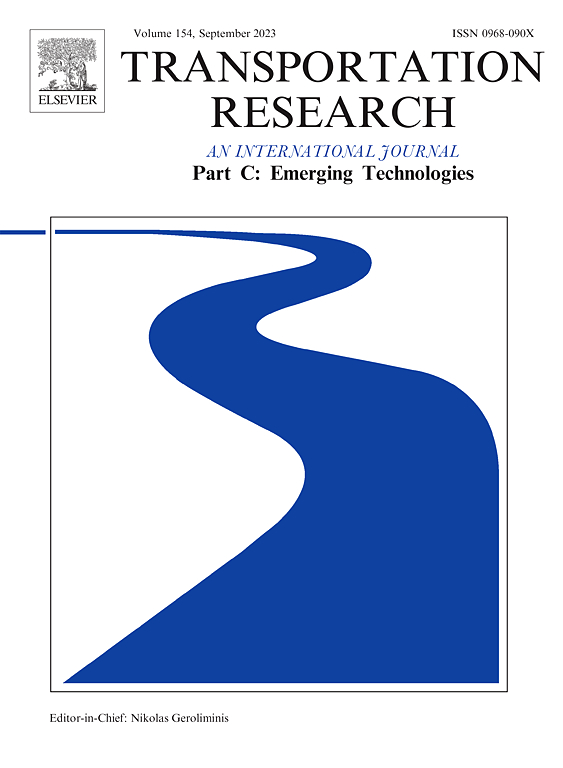同时选择路径和出发时间和战略出行时间信息的多班次日内动态交通平衡
IF 7.6
1区 工程技术
Q1 TRANSPORTATION SCIENCE & TECHNOLOGY
Transportation Research Part C-Emerging Technologies
Pub Date : 2025-07-09
DOI:10.1016/j.trc.2025.105269
引用次数: 0
摘要
大多数具有信息供给的日内动态交通均衡研究都隐含地考虑了出行时间信息,通常根据出行者的感知误差假设信息是完美的或不完美的。然而,缺乏明确的信息表述限制了对动态流量平衡的信息影响的深刻分析,以及利用信息提供提高系统级性能的潜在好处。为了解决这一差距,本文提出了一个日内动态流量平衡模型,该模型明确地将战略信息提供作为一个内生因素。提出的模型考虑了旅行者对信息的反应,在提供的信息和交通动态之间建立了相互依赖的关系。在这个框架中,两类旅行者接收到不同类型的旅行时间信息:一类人接收到反映当前交通状况的瞬时旅行时间,而另一类人接收到基于行为博弈论策略思维的旅行者对瞬时信息的反应而产生的旅行时间战略预测。通过明确建模信息提供和考虑信息一致性,所得到的多类日内动态平衡不同于现有模型。对实时更新的交通信息、交通状况和出行者选择行为的内在动态进行了解析建模,并将动态平衡表述为一个不动点问题。本文的理论命题和数值结果对信息对交通网络的影响、战略预测信息渗透、所提出的均衡与传统动态交通均衡之间的关系以及信息准确性等方面提供了丰富的见解。本研究有助于深入了解信息与交通动态之间的相互作用,为制定更有效的交通管理策略铺平道路。本文章由计算机程序翻译,如有差异,请以英文原文为准。
Multi-class within-day dynamic traffic equilibrium with simultaneous path-and-departure-time choices and strategic travel time information
Most research on within-day dynamic traffic equilibrium with information provision implicitly considers travel time information, often assuming information to be perfect or imperfect based on travelers’ perception error. However, lacking explicit formulation of information limits insightful analysis of information impact on dynamic traffic equilibrium and the potential benefits of leveraging information provision to improve system-level performance. To address this gap, this paper proposes a within-day dynamic traffic equilibrium model that explicitly formulates strategic information provision as an endogenous element. The proposed model considers travelers’ reactions to the information, creating an interdependent relationship between provided information and traffic dynamics. In this framework, two classes of travelers receive different types of travel time information: one class receives instantaneous travel time reflecting the prevailing traffic conditions, while the other class receives strategic forecasts of travel times, generated by accounting for travelers’ reactions to instantaneous information based on strategic thinking from behavioral game theory. The resulting multi-class within-day dynamic equilibrium differs from existing models by explicitly modeling information provision and consideration of information consistency. The inherent dynamics of real-time updated traffic information, traffic conditions, and travelers’ choice behaviors are analytically modeled, with the resulting dynamic equilibrium formulated as a fixed-point problem. The theoretical propositions and numerical findings offer rich insights into the impact of information on the traffic network, strategic forecast information penetration, the relationship between the proposed equilibrium and traditional dynamic traffic equilibria, and information accuracy. This research contributes to a deeper understanding of the interplay between information and traffic dynamics, paving the way for more effective traffic management strategies.
求助全文
通过发布文献求助,成功后即可免费获取论文全文。
去求助
来源期刊
CiteScore
15.80
自引率
12.00%
发文量
332
审稿时长
64 days
期刊介绍:
Transportation Research: Part C (TR_C) is dedicated to showcasing high-quality, scholarly research that delves into the development, applications, and implications of transportation systems and emerging technologies. Our focus lies not solely on individual technologies, but rather on their broader implications for the planning, design, operation, control, maintenance, and rehabilitation of transportation systems, services, and components. In essence, the intellectual core of the journal revolves around the transportation aspect rather than the technology itself. We actively encourage the integration of quantitative methods from diverse fields such as operations research, control systems, complex networks, computer science, and artificial intelligence. Join us in exploring the intersection of transportation systems and emerging technologies to drive innovation and progress in the field.

 求助内容:
求助内容: 应助结果提醒方式:
应助结果提醒方式:


